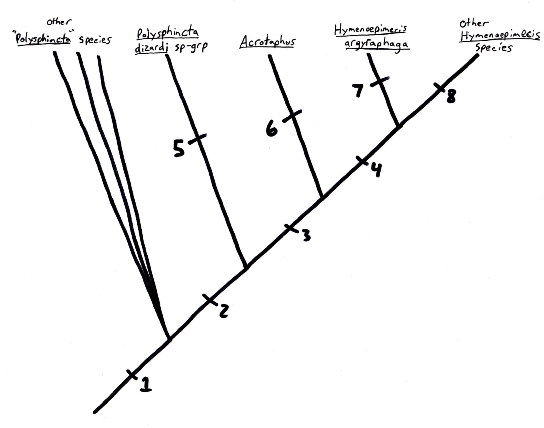Classification
Domain: Eukarya
Kingdom: Animalia
Phylum: Arthropoda
Class: Insecta
Order: Hymenoptera
Family: Ichneumonidae
Genus: Hymenoepimecis
Species: Hymenoepimecis argyraphaga
(Myers et. al, 2012)
Understanding this species name:
Hymenoepimecis argyraphaga
Hymeno- refers to a membrane
-epi- refers to the outside perimeter
argyra- refers to a spider
-phaga refers to ingestion/digestion
Defining the Groups
--> Eukarya: Simply put, a eukaryotic organism is one that is composed of eukaryotic cells. This means their cells will have a variety of organelles such as: mitochondria, golgi apparatus and possibly even chloroplasts. [To see a chloroplast containing organism, look here to view apples!] In addition, a membrane-bound nucleus must be present which contains DNA organized into chromosomes. (Columbia Encyclopedia, 2012) With the below image, one is able to see the great phylogenetic tree of life courtesy of Eric Gaba.
Eukaryotes, along with Bacteria and Archaea, make up the three major
domains of all life. This particular tree was configured by Carl
Woese by looking at numerous amounts of RNA data.
--> Animalia: This kingdom, sometimes referred to as the Metazoa,
contains quite an array of creatures that many would be most
familiar with. It is important to note that all animals are both
heterotrophic and multicellular, unlike some species like the
bacteria
Escherichia coli. On the molecular level, it is seen that
animal cells are mostly diploid and don't exhibit rigid cell walls,
like that seen in the kingdom Land Plants. The fine details of the
Animalia lineage are not clear and cannot be decided upon, but the
idea that Animalia is a monophyletic group is widely accepted.
(Dewey, TA., 2002). Again, the diversity in this group is
tremendous; it ranges from such species as the
bighorn
sheep to the
Beluga
Whale.
--> Arthropoda: Found in this phylum are all of what one would
consider the "creepy crawlies". Such organisms as the
mayfly and the
Eastern
Asian ant fall into this category. Such things as segmented
bodies, a coelom body cavity and exoskeletons characterize
Arthropoda. (For more information on the history and evolution of
coeloms, visit
this
site.) Also, because Arthropoda are a part of the ecdysozoans,
they are prone to molting. (Columbia Encyclopedia, 2012)
--> Insecta: This class is in fact the largest and most diverse of
the Arthropoda phylum. To better suit their environments, insects
have adapted quite a variety of feeding structures and food
acquisition techniques. These organisms feed upon many human
agricultural crops, domesticated animals and even parasitizing
humans (Columbia Encyclopedia, 2012). See the
deer tick for a closer look at parasitic arthropods. In
addition, there are insects that prey upon the nutrients flowing
through trees such as the
emerald
ash borer.
--> Hymenoptera: The presence of two pairs of wings, both fore wings
and hind wings, along with ovipositors, antennae and pupation via a
cocoon are the basis for this order. (Allaby, 2012)
--> Ichneumonidae: For this family, the characters of the
hymenoptera have been narrowed. For instance, the antennae are said
to have at least sixteen segments and be at a length of the the body
span. The body plan is characterized as slender and wasp-like. In
North America alone, there are around 5000 species described. (Bugguide,
2012)
--> Hymenoepimecis: Very specifically, this clade of
neotropical wasps are all koinobiont ectoparisitoids of spiders (Gauld,
2000). I will detail this more later.
--> Hymenoepimecis argyraphaga: As seen in the tree below,
this particular species is highly derived. It seems that the
defining trait setting the H. argyraphaga wasp apart from
the rest of its genus is its entirely black wing structure. The
synapamorphies are specific to the morphological features setting
each organism or group of organisms apart.

Onward to Habitat!
